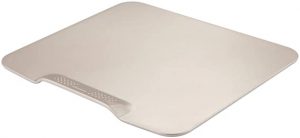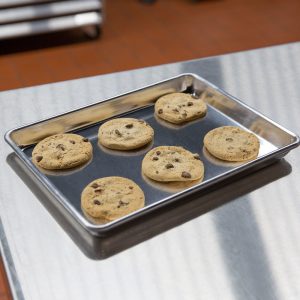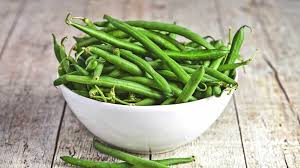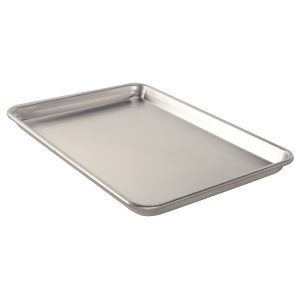
A sheet pan, baking sheet or cookie sheet is a kitchen workhorse that has so many uses. There is a great variety of sheet pans out there, but even a cheap one will usually get the job done, at least for a while.
What makes a good sheet pan is simple. It needs to be flat, clean up easily and hold low-rise foods, like cookies. They are usually rectangular and have a low rim. They have to handle high heat and be reliable.
Every kitchen needs one of these. In big commercial kitchens, the sheet pans are huge, able to handle large quantities of food. But in the home kitchen what’s needed is actually called a half sheet pan. Baking sheets and cookie sheets, they are all the same thing. When your stocking your first kitchen, it doesn’t matter much how good it is as long as it does what’s needed. But as you grow in kitchen experience, you’ll find you want something a little better. So, what do you need to consider?
Material Matters
There are three basic choices for what your pan is made of: aluminum, steel, or a combination called aluminized steel. Aluminum is what you find the most. It heats up and cools down quickly. But it corrodes easily so special care must to taken to keep it in good shape as long as possible. There are two fixes to this problem thus reducing the amount of washing needed. One is to buy cookie sheet liners made of silicone. They can take the heat pretty well and protect the sheet pan underneath. These also have the advantage of having a textured surface to allow better airflow. You can also buy sheet pans with this property, we’ll get to that later.
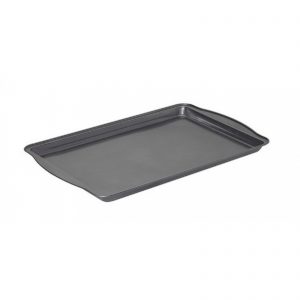
Another solution to the corroding problem with aluminum sheet pans is to keep them covered for every use. Unless something bleeds through, you can just remove the cover and throw that away while putting the sheet pan back in the cabinet. Aluminum foil is always good, but in many cases is not needed. Parchment paper is a better choice for something dry or large. But the key here is to keep from having to wash this pan so often, reducing the chance for corrosion.
Stainless steel gets rid of the corrosion problem since it is more resistant to rust than aluminum. The problem with this pan is that steel is a poor conductor of heat. That means it takes longer to heat up, often heats unevenly, and longer to cool down. These types of pans should only be used for roasting and broiling, never baked goods.
Aluminized steel is a steel sheet pan coated with an aluminum-silicon alloy. These pans tend to be more durable, which means more expensive. The silicone helps to prevent corrosion, however, it also retards an even spread of the heat, giving you hot spots.
To Coat Or Not To Coat
Most baking sheets you’ll see are uncoated. If you want to prevent sticking, put parchment paper over the inside of the pan. Coated pans will reduce sticking, for a while. Repeated washings will wear away the coating over time. So unless you have something special in mind, you can skip the coatings.
Of course, that is one exception to the coating rule. That’s when the pan has a ceramic coating. It holds up well under high heat but it takes longer to heat up. That means baked goods will take a little longer, but the coating heats more evenly, so you shouldn’t burn your cookies. These also clean up well and are virtually non-stick.
Rimmed For Your Pleasure
Most baking sheets, cookie sheets or whatever you call them, have a small rim around the edge, usually about a quarter inch. The metal is first pressed out of metal then the edges are folded and the very edge rounded. The rim helps keep everything inside the pan while its shortness allows better circulation of air and heat than a roasting pan with higher sides. The rolled edge also helps keep the pan from warping and buckling compared to flat-rimmed or no-rim pans. Some pans have an aluminum rod in the rolled metal to prevent warping and buckling in high heat.
However, serious bakers may want to invest in some rimless pans. Because they have only one or no rim, the goods on it slide off much easier.
Rims will come in all shapes and sizes from the low rise of the cookie sheet to the taller rims of a professional baker’s half-sheet pan. Some will slant, allowing food to be more easily removed while keeping any liquids in.
Size May Or May Not Matter
Restaurant style sheet pans are designed to fit into commercial ovens, which are much wider than your home range. A half-sheet pan is what most cooks need. They can range in size from 11” X 17” to 13” X 18”.
But here’s something you might not have thought about. Have you ever wanted to cook just one baked potato or heat up a couple fish fillets? That cookie sheet looks too big for the job. The answer is quarter sheet pans. They are great when you’re just heating something small or just a single serving. You might find a quarter sheet pan a worthy addition to your kitchen stock.
Another aspect of size to consider comes when you have a particularly small oven. Sometimes called an apartment size oven, at most it would take a regular cookie sheet, but might not be able to handle some models with wider handles.
What’s Your Gauge?
Gauge is a measurement of the thickness of the metal. The higher the number, the thinner the metal. You probably won’t have much choice in this area, but most chefs recommend 18-gauge as having substantial thickness but are also light enough to handle easily.
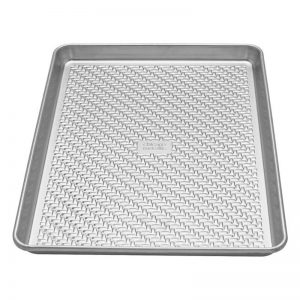
Does Texture Matter?
Earlier I said that a textured surface allows for better air and heat circulation compared to a flat surface. Nearly all baking sheets are smooth. But there are some, usually designed just for baking, that comes with a diamond texture surface and only one rimmed side. If you do a lot of baking, this is a worthy investment, but don’t use it to make a sheet pan dinner. You’ll just have a mess on your hands.
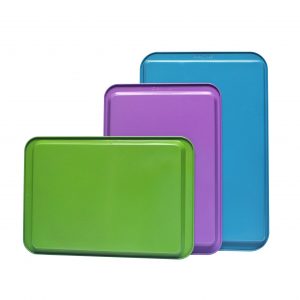
But there are textured pans that look more like a traditional baking sheet. Test have found the textured pan bottom improves durability and more even baking.
Sheet Pan Dinner Sheet Pans
This is only on a small scale of baking sheets that double as serving ware. A few companies are putting out brightly colored baking sheets that go from oven to table, preferably on some trivets. They have a ceramic coating but are not lightweight.
These pans are all multi-taskers in the kitchen. Buy the best you can afford and what’s right for your type of cooking.
